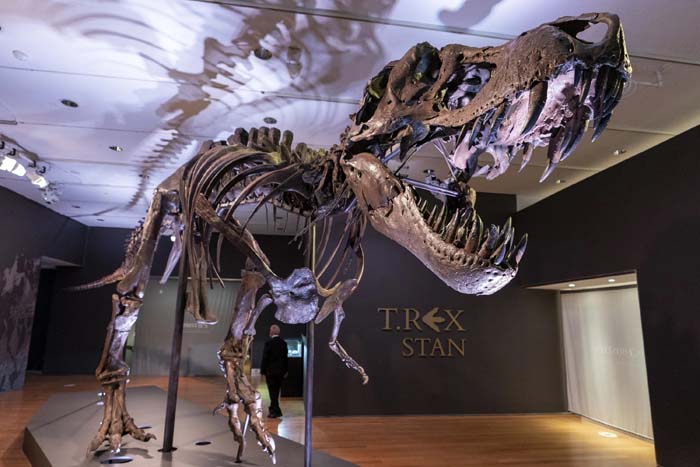News of the weird: Has T. rex lost its bite? Menacing snarl may be wrong
Published 12:17 pm Sunday, April 2, 2023

- Stan, one of the largest and most complete Tyrannosaurus rex fossil discovered, is on display, Tuesday, Sept. 15, 2020, at Christie's in New York. The teeth on T. rex and other big theropods were likely covered by scaly lips, concludes a study published Thursday, March 30, 2023, in the journal Science. The dinosaur's teeth didn't stick out when its mouth was closed, and even in a wide open bite, you might just see the tips, the scientists found.
NEW YORK — The Tyrannosaurus rex is often shown baring massive, sharp teeth, like the ferocious creature in “Jurassic Park.” But new research suggests that this classic image might be wrong.
The teeth on T. rex and other big theropods were likely covered by scaly lips, concludes a study published Thursday in the journal Science. The dinosaur’s teeth didn’t stick out when its mouth was closed, and even in a wide open bite, you might just see the tips, the scientists found.
The research is the latest in a long back-and-forth over how dinosaur mouths really looked.
Recent depictions show big teeth jutting out of the dinosaurs’ jaws, even when closed. Some thought the predators’ teeth were just too big to fit in their mouths, said study author Thomas Cullen, a paleontologist at Auburn University in Alabama.
When researchers compared skulls from dinosaurs and living reptiles, though, they found this wasn’t the case. Some large monitor lizards actually have bigger teeth than T. rex compared to their skull size, and can still fit them under a set of scaly lips, Cullen said.
The scientists also found clues in the pattern of wear and tear on tooth surfaces.
For a creature like a crocodile, whose teeth stick out of its mouth, the exposed part gets worn down quickly — “like someone’s taken a sander to the side of the tooth,” said another study author Mark Witton, a paleoartist at England’s University of Portsmouth.
But when researchers analyzed a tooth from a Daspletosaurus, a T. rex relative, they found it was in good condition and it didn’t show that uneven damage pattern.
With this evidence and other clues from the dinosaurs’ anatomy, the study makes a good case for lipped tyrannosaurs, said University of Maryland paleontologist Thomas Holtz, who was not involved with the study. Still, “we’re not talking kissy lips,” he pointed out — they’d be thin and scaly like those of the Komodo dragon, a large lizard.
It’s not the first time our depictions of dinosaurs have been called into question: Other research has shown that T. rex was more hunched over than we used to think, and that fierce velociraptors probably sported feathers. Most of what we know about dinosaurs comes from their bones, but it can be harder to get clear answers about soft tissues like skin, which usually aren’t preserved as fossils.
Adding lips may make dinosaurs look a little less ferocious, but it also makes them feel more realistic, Witton said.
“You don’t really see a monster,” he said. “You see an animal.”
Twitter pulls check mark from main New York Times account
NEW YORK — Twitter has removed the verification check mark on the main account of The New York Times, one of CEO Elon Musk’s most despised news organizations.
The removal comes as many of Twitter’s high-profile users are bracing for the loss of the blue check marks that helped verify their identity and distinguish them from impostors on the social media platform.
Musk, who owns Twitter, set a deadline of Saturday, April 1, for verified users to buy a premium Twitter subscription or lose the checks on their profiles. The Times said in a story March 30 that it would not pay Twitter for verification of its institutional accounts.
Early April 2, Musk tweeted that the Times’ check mark would be removed. Later he posted disparaging remarks about the newspaper, which has aggressively reported on Twitter and on flaws with partially automated driving systems at Tesla, the electric car company, which he also runs.
Other Times accounts such as its business news and opinion pages still had either blue or gold check marks on April 2, as did multiple reporters for the news organization.
“We aren’t planning to pay the monthly fee for check mark status for our institutional Twitter accounts,” the Times said in a statement. “We also will not reimburse reporters for Twitter Blue for personal accounts, except in rare instances where this status would be essential for reporting purposes.”
The Associated Press, which has said it also will not pay for the check marks, still had them on its accounts at midday April 2.






